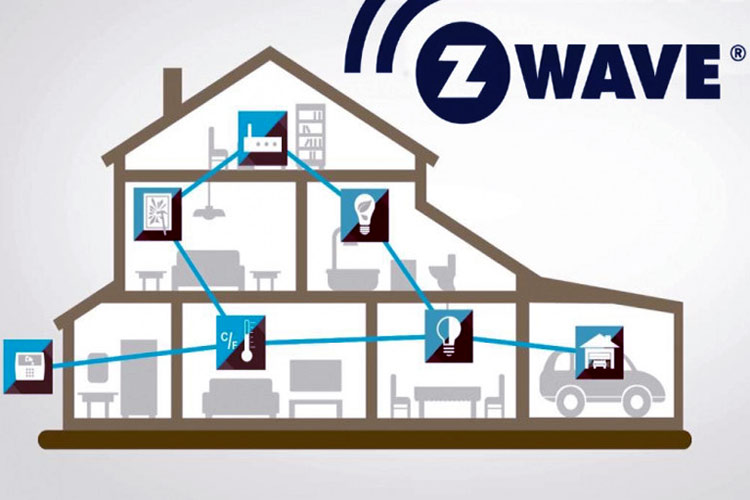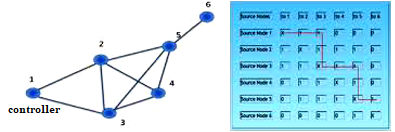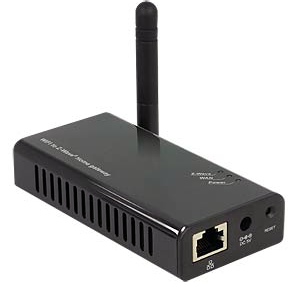
As applications based around Wireless Sensor Networks, Home Automation, and IoT increased, the need for alternative communication protocol asides the regular Bluetooth, Wi-Fi, and GSM protocols was becoming obvious. Several technologies like Zigbee and Bluetooth Low Energy (BLE) were developed as alternatives but one standout technology, developed to specifically serve home automation applications was Z-Wave. For today’s article, we will examine the technicalities of Z-wave, it’s differentiating features, the Standard, and much more.
What is Z-Wave
Z-Wave is a wireless communications protocol developed primarily for use in home automation applications. It was developed in 1999 by Copenhagen based Zensys as an upgrade to a consumer light-control system they created. It was designed to provide the reliable, low-latency transmission of small data packets using low-energy radio waves at data rates up to 100kbit/s with a throughput of up to 40kbit/s (9.6kbit/s using old chips) and are suitable for control and sensor applications.

Based on the mesh network topology and operating within the unlicensed 800-900MHz (actual frequency varies) ISM frequency band, Z-Wave based devices are able to attain a communication distance of up to 40 meters, with the additional ability of messages to Hop up between up to 4 nodes. All of these features make it a suitable communication protocol for home automation applications like lighting control, thermostats, windows controls, locks, garage door openers, and many more while avoiding the problematic congestions associated with Wi-Fi and Bluetooth due to their use of the 2.4GHz and 5GHz bands.
How does Z-Wave Protocol Work?
To understand the working of Z-Wave Protocol let's analysis the subject in three main sections namely the Z-Wave System Architecture, Data Transmission/Reception, and Routing and Connecting to the Internet
Z-Wave System Architecture:
Every Z-wave network comprises of two broad categories of devices;
- Controller/Master(s)
- Slaves
The master ordinarily serves as the host of the Z-Wave network to which other devices (Slaves) can be connected. It usually comes with pre-programmed NetworkID (sometimes called HomeID) that is assigned to each slave (which does not come with a pre-programmed ID) when they are added to the network through a process called “inclusion”. Asides the HomeID, for every device added to the Z-wave network, an ID called the NodeID is usually assigned by the controller. The NodeID is unique on every network (for every HomeID), as such, it is used to address and primarily recognize each device on a particular network.
Inclusion is similar in intent to how a router assigns IP addresses to devices on its network, while the masters are similar to routers/gateways/Device Hubs, with the only difference being the mesh relationship the masters have with slaves in the network. To remove nodes from a Z-Wave network a process called “Exclusion” is performed. During exclusion, the Home ID and the Node ID are deleted from the device. The device is reset to the factory default state (controllers have their own Home ID and slaves have no Home ID).
The HomeID and NodeID mentioned above are the two identification systems defined by the Z-wave protocol for easy organization of the Z-wave network.
The HomeID is the common identification of all nodes that are part of a particular Z-Wave network, while the NodeID is the address of individual nodes within a network.
The HomeIDs are usually Pre-Programmed and unique, and they define the particular Z-wave network. They come in a length of 32 bits which means it’s possible to create up to 4 billion (2^32) different HomeIDs and different Z-wave networks. The Node ID, on the other hand, is just a byte(8 bits) in length which means we could have up to 256(2^8) nodes in a network.
Asides from allowing easy addressing of nodes, the Identification system helps to prevent interference in Z-wave networks because two nodes with different HomeIDs cannot communicate even if they have the same NodeID. This means you could deploy two z-wave networks side by side without an interfering charter from Network A being received by B.
Data Transmission, Reception, and Routing:
In typical wireless networks, the central controller/master has a direct, one-to-one wireless connection to the nodes in the Network. As useful as that arrangement is for those protocols, it creates a limitation around data transmission such that “Device A” will not be able to interact with “Device B” if there is a break in the link between either of them and the master. This is, however, not the case for Z-waves thanks to its Mesh network topology, and the ability of Z-wave nodes to forward and repeat messages to other nodes. This ensures that communication can be made to every node in a network even when they are not in the direct range of the controller. To better understand this, consider the Image below;

The Z-wave network illustration shows the controller can communicate directly with the devices 1, 2, and 4, while Node 6 is outside its radio range. However, due to the features described earlier, Node 2 will assume a repeater/forwarder status and extend the range of the controller to Node 6 such that any message heading to Node 6 will be passed through Node 2. Nodes like Node 2 in large networks are called routes and they contribute to the flexibility and robustness of Z-wave Networks. To determine which of the routes messages should travel to reach a particular Node, Z-wave networks use a tool called a routing table.

Every node in a Z-wave network is able to determine the other nodes (called Neighbors) in its direct wireless coverage area and during Inclusion or later, the node informs the controller about these neighbors. Using the list of neighbors from each Node, the controller creates a routing table that is used to map routes to Nodes that are outside of the controller’s direct wireless range.
It is important to note that not all Nodes can be configured as forwarders. The Z-wave protocol only allows Nodes that are Plugged-in (not battery powered) to serve as “Routing Nodes”.
Connecting to the Internet:
Using the recent “Gateway/Aggregator” approach by other protocols, a Z-Wave system can be controlled via the Internet using a Z-Wave gateway or Controller(master) device serving as both the hub controller and portal to the outside. An example of this is the Delock78007 Z-Wave® Gateway.

Z-Wave Alliance
While the first Z-wave based devices were released as early as 1999, the technology did not really catch-on until 2005 when a group of companies including Home automation giant Leviton, Danfoss, and Ingersoll-Rand adopted Z-Wave and formed an alliance called the Z-Wave Alliance.
The Alliance was formed to promote the use and interoperability of Z-Wave technology and devices based on it. In line with this, the alliance develops and maintains the Z-wave standard, and certifies all Z-Wave based devices to ensure they comply with the standard. The alliance started with 5 member companies but now has over 600 companies producing more than 2600 Z-Wave certified devices.
Difference between Z-Wave and Other Protocols
To understand why it makes sense to have another communication protocol like Z-wave, we will compare it with some other communications protocols used in home automation including; Bluetooth, WiFi, and Zigbee
Z-wave vs Bluetooth:
The most pronounced advantage of Z-Wave over Bluetooth is Range. Z-waves have an effectively larger coverage area than Bluetooth. Also, Bluetooth signals are prone to interference and interruption because they send and receive information on the 2.4GHz band, thereby competing for Bandwidth with WiFi-based Devices using the same frequency band.
With Z-wave, rather than make the network slower or noisy, every Z-wave signal repeater works together to make the network stronger, such that, the more devices you have, the easier it is to create a robust network, capable of bypassing obstacles.
Z-wave vs WiFi:
Like Bluetooth, WiFi-based networks are also susceptible to interference, interruption and range related issues and as such perform below Z-wave based networks under those circumstances.
Asides competing for bandwidth with Bluetooth devices, WiFi devices also compete with one another and this could affect the signal strength and network speed in homes where lots of devices are based on WiFi. This is not the case with Z-wave as the network flourishes with the addition of more devices to the Network.
WiFi-based devices, however, have an upside in comparison with Z-waves. They are able to send larger information like HD video Streams and more, while Z-wave based networks are able to handle small bytes of data like sensor data or instructions to turn on/off a light bulb.
Z-wave vs. Zigbee:
Zigbee is another wireless technology and like Z-wave, it was designed with Home Automation and nearby wireless sensor networks in mind. Like Z-wave, it is based which is on the Mesh network topology and each device on a Zigbee network helps strengthen the signal. However, unlike Z-wave, it operates on the 2.4GHz frequency band which means it also competes for bandwidth with WiFi and Bluetooth and may also be prone to the interference and network speed challenges associated with them.
Another difference whose significance I will leave you to decide is the fact that, while Z-Wave is a proprietary technology (although there are plans to make the software open source), Zigbee is open-source.
Z-Wave Advantages and Disadvantages
Like all things, Z-Wave has both advantages and disadvantages. We will discuss them one after the other.
Pros of Z-Wave
Some of the advantages of Z-waves include;
- The ability to support 232 devices in theory and at least 50 in practice.
- Signals can travel up to 50 feet indoors allowing for obstructions and up to 100 feet unobstructed. This reach is extended considerably outdoors. With the four hops between devices further enhancing the range, coverage won’t be a problem in sprawling connected homes.
- The Z-wave alliance is made up of up to 600 manufacturers producing over 2600 certified devices to ensure compatibility.
- Less interference due to the ISM band being used.
- Less dead spots compared to other networks, thanks to the robust mesh topology
- It is Affordable and easy to use.
Cons Z-Wave
Unlike some of the other communication protocols, Z-Waves was specifically designed for use in Home Automation applications, as such, it was tailored to the application needs and bear very little disadvantages. However, the workable limits of 50 devices rather than the notional 232, can be a challenge in homes where more than 50 devices need to be deployed.
Also, its inability to sustain the transfer of large bytes of data makes it not so useful in applications like video surveillance, where megabytes of data need to be streamed between end devices.
Conclusion
Z-waves are to home automation what LoRa is to the broader IoT landscape. The biggest advantage it has over all the other protocols in the Home Automation niche is the fact that it was designed for that niche. This means it will generally perform better than other protocols that were designed for broader consumption, and it will perform relatively well for, at least, 80% of the applications in that niche.





